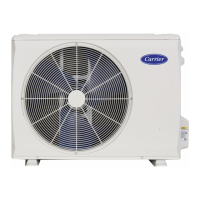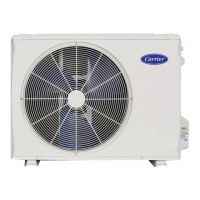
Do you have a question about the Carrier 38MARBQ12AA3 and is the answer not in the manual?
Provides guidelines for power and communication wiring connections.
Explains the deep vacuum method for system evacuation using a vacuum pump.
Outlines the triple evacuation method for system evacuation.
Instructions for checking tubing integrity before final assembly.
Details main protection functions like compressor restart delay and high temp cutout.
Explains operation modes (FAN, COOLING) and compressor/fan running rules.
Describes the unit's operation in FAN mode.
Covers compressor and outdoor fan running rules in COOLING mode.
Defines indoor fan operation rules for COOLING and HEATING modes.
Explains compressor temperature protection mechanisms.
Describes evaporator temperature protection that stops the compressor.
Details compressor and outdoor fan running rules for HEATING mode.
Describes evaporator coil temperature protection that stops the compressor.
Explains AUTO mode selection and unit behavior.
Details the DRYING mode operation and low room temperature protection.
How to enter and use forced operation modes (AUTO, COOLING).
Explains operation rules for FORCED COOLING and FORCED AUTO modes.
Describes the auto-restart function after a power failure.
Details refrigerant leakage detection and its display indication.
Describes fan and compressor operation during 46°F (8°C) heating.
Describes how to enter and exit the forced DEFROSTING mode.
Lists conditions that will cancel the DEFROST mode and revert to HEATING.
Important safety notes regarding electrical discharge before troubleshooting.
Details outdoor unit error displays and their corresponding solutions.
Troubleshooting for EEPROM parameter or compressor driven chip errors.
Troubleshooting for indoor/outdoor unit communication errors (EL01).
Troubleshooting for zero crossing detection errors (EH02).
Troubleshooting for indoor fan speed operating outside normal range (EH03).
Checks for DC fan motor voltage input and output.
Troubleshooting for outdoor fan speed operating outside normal range (EC07).
Procedures for checking outdoor DC fan motor resistance and voltage.
Troubleshooting for indoor temperature sensor faults (EH60).
Troubleshooting for outdoor temperature sensor faults (EC53).
Troubleshooting for refrigerant leakage detection (EL0C).
Troubleshooting for indoor PCB/display board communication errors (EH06).
Troubleshooting for current overload protection (PC08).
Troubleshooting for IPM malfunction or IGBT over-current protection (PC00).
Procedure for checking IPM continuity.
Procedure for checking compressor resistance.
Troubleshooting for over/low voltage protection (PC01).
Troubleshooting for compressor temp/IPM temp/high pressure protection (PC02).
Troubleshooting for inverter compressor drive errors (PC04).
Troubleshooting for low pressure protection (PC03).
Describes mode conflicts between indoor units in multi-unit systems.
Troubleshooting for communication errors between outdoor main chip and compressor chip (PC40).
Procedure for checking temperature sensors using a multimeter.
Procedure for checking compressor resistance values.
Procedure for checking IPM continuity.
Procedure for checking the 4-way valve voltage and resistance.
Procedure for checking the Electronic Expansion Valve (EXV) winding resistance.
Procedure for checking temperature sensors and their resistance values.
Disassembly instructions for the outdoor unit panel plate.
Disassembly instructions for the outdoor unit panel plate (24K, 208-230V).
Steps to remove the fan motor.












